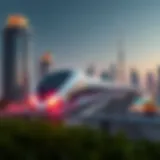Discovering Al Fahidi: Dubai's Historical Gem
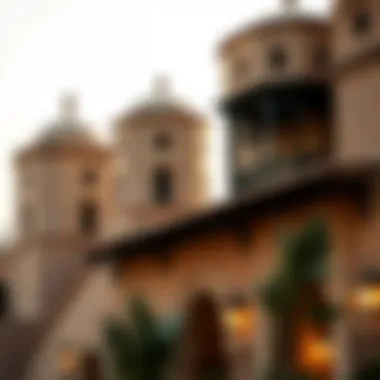

Intro
Al Fahidi, often regarded as the soul of Dubai, stands as a remarkable blend of history and modernity. This neighborhood, with its narrow lanes and traditional wind-tower architecture, reflects the essence of not just a bygone era but also the ongoing evolution of one of the fastest-growing cities in the world. The juxtaposition of ancient culture against the backdrop of sleek skyscrapers creates a unique landscape, fostering a deep connection to the rich Emirati heritage that often gets overshadowed by Dubai’s rapid expansion.
Visitors and locals alike can’t help but be drawn to Al Fahidi’s authentic charm. The area houses numerous art galleries, museums, and cultural institutions, particularly the Dubai Museum, which resides in the Al Fahidi Fort. Each building tells a story of resilience, tradition, and the Emirati way of life.
Recent times have seen Al Fahidi adapt to the changing tides, attracting attention not only from tourists but also from investors keen on tapping into Dubai's real estate sector. This article delves into the intricacies of Al Fahidi, exploring its historical significance, current market trends, and investment opportunities that align with the rich tapestry of this historic district.
As we navigate through the various dimensions of Al Fahidi, we aim to uncover valuable insights for investors, property enthusiasts, and expatriates who wish to embrace the convergence of the old and the new in Dubai's vibrant landscape.
Prolusion to Al Fahidi
Al Fahidi is not merely a neighborhood. It's a snapshot of Dubai's past, whispered through the walls of its wind-towered buildings and narrow lanes. For investors, agents, and anyone with a keen eye on real estate trends, understanding Al Fahidi is crucial. It represents a multifaceted narrative of heritage intertwined with the demands of modern life. This section will explore its historical depth and cultural essence, laying down the groundwork for the subsequent examination of architectural intricacies and attractions.
Historical Overview
Al Fahidi’s roots trace back to the 19th century, marking it as one of the oldest districts in Dubai. Initially, this area flourished as a trade center, where merchants exchanged goods from diverse cultures, trading spices, textiles, and more. It is said that the influx of trade fostered a melting pot of traditions, setting against the backdrop of the Persian Gulf. Interestingly, much of the original architecture remains intact, showcasing the building techniques that have surprisingly stood the test of time. The structures were designed to reflect the local environment, with materials sourced directly from the surrounding landscape, making them not just functional but also harmonious with nature.
Cultural Significance
As a cultural cornerstone, Al Fahidi serves a dual purpose: it preserves the Emirati way of life while embracing the rapid transformations of contemporary Dubai. The neighborhood offers a glimpse into traditional Emirati culture through its art galleries, museums, and communal spaces. Residents and visitors alike often gather in quaint courtyards, which echo laughter and stories from generations past.
It's worth noting that Al Fahidi has become increasingly vital in discussions of cultural sustainability in urban settings. It champions local arts and crafts, providing a space for artisans to thrive. Al Fahidi stands as a testament to the city's commitment to honoring its heritage even amidst the buzz of modernity.
Architectural Features
The architectural features of Al Fahidi are nothing short of a visual diary narrating the evolution of Dubai. Beneath those intricate facades lies a story that intertwines heritage with contemporary living. For investors, agents, and expatriates alike, understanding these features is essential for grasping the unique spirit of the neighborhood. With elements that promote sustainability as well as cultural preservation, Al Fahidi stands as a prime example of how architecture can embrace both history and modernity.
Traditional Wind Towers
Wind towers, or barjeels, are one of the defining characteristics of Al Fahidi's architectural scene. These towering structures act like natural air conditioning systems that have been utilized for centuries. By siphoning the breeze from above into living spaces below, they create a cool microclimate that makes the sweltering desert more hospitable. In a neighborhood that prides itself on its sustainable practices, these wind towers represent an ingenious solution to climate challenges long before modern technology caught up.
The aesthetic appeal of wind towers also enhances the historic charm of Al Fahidi. They stand tall, often embellished with ornate carvings and positioned prominently in many courtyards. They invite both local and visiting architects to appreciate the intricate craftsmanship of past artisans. For modern developers, integrating such features into new projects could offer an attractive selling point—merging eco-friendliness with the allure of traditional design.
"The barjeels not only reflect architectural resilience but also serve as a reminder of a lifestyle that prioritized harmony with nature."
Narrow Alleyways and Courtyards
Wandering through the narrow alleyways of Al Fahidi is like stepping into a living museum. These winding paths weave through the neighborhood, leading you to hidden courtyards adorned with vibrant plants and local art. Such a layout isn't merely for aesthetics; it's a practical design that fosters community. The narrow sides ensure shade during the hot months while also providing a sense of intimacy among neighbors. This architectural approach reflects a lifestyle centered around social gatherings, making it a hotspot for cultural events.
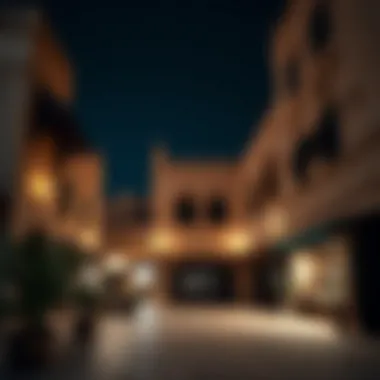

The courtyards often serve as communal spaces where residents gather for coffee, discussions, or storytelling sessions. Here, that earthy charm invites the spirit of neighborliness that sometimes seems absent in modern high-rises. From an investment perspective, properties adjacent to these well-maintained alleyways can fetch higher values, particularly among buyers who appreciate the importance of community and cultural atmosphere.
In summary, Al Fahidi’s architectural features are crucial not only for maintaining its identity but also for enhancing its market appeal. They whisper tales of the past while situating themselves firmly in the future. As Dubai embraces rapid modernization, the retention of these features will ensure that Al Fahidi remains a significant hub for culture, history, and real estate prospects.
Cultural Attractions within Al Fahidi
Al Fahidi is more than a mere collection of historical buildings; it's a vibrant canvas where the past mingles with the present, providing a variety of cultural attractions that leave a lasting imprint on both tourists and locals alike. This section delves into key cultural touchstones within Al Fahidi, illustrating their significance in fostering a deeper understanding of Dubai’s multifaceted heritage.
Dubai Museum
Nestled within the walls of the Al Fahidi Fort, the Dubai Museum is a treasure trove. Established in 1971, it plays a pivotal role in narrating the story of Dubai’s evolution from a modest fishing village into a global metropolis. Visitors can meander through the museum's exhibits, which showcase artifacts, traditional crafts, and life-sized dioramas that depict scenes from the past.
The interactive displays and audiovisual presentations bring history to life, making it more than just a static exhibition. The museum houses various themes, from ancient trade routes to the cultural influences that shaped the UAE, capturing a wide array of influences from across the region. It's not just a collection of relics; it's an engaging experience that deepens one's appreciation for the spirit of Dubai.
"The Dubai Museum acts as a cultural bridge, connecting generations and preserving the essence of Emirati identity in a rapidly changing world."
Art Galleries and Studios
The art scene within Al Fahidi is bursting with creativity and flair. Numerous art galleries and studios line the narrow streets, showcasing the works of both established and emerging artists. These galleries serve as platforms for local talent, offering a glimpse into contemporary Emirati art while simultaneously paying homage to traditional styles.
Visitors can witness various forms of artistic expression, from paintings and sculptures to installations that provoke thought and discussion. Notable venues include the
- Majlis Gallery, known for its exhibitions of traditional Islamic art
- Cultural Foundation, focusing on the preservation of local heritage in modern contexts
Each gallery is distinct, often featuring rotating exhibitions that keep the local art scene dynamic. As one strolls through these revered spaces, it becomes clear that the heartbeat of Al Fahidi lies in its artistic community, continually redefining what it means to create art in the desert.
Cultural Markets
Cultural markets in Al Fahidi, often called souks, are not just places to shop; they’re venues where traditions come alive. The bustling atmosphere here is complemented by the vibrant colors and intricate designs of local handicrafts, textiles, and spices. These markets reflect the spirit of Al Fahidi, marrying commerce with culture.
Among the most notable souks is the Textile Souk, offering a sensory overload of fabrics and colors. Visitors can engage with shopkeepers who often recount the history behind their goods, imparting stories of cultural significance embedded within the textiles. Furthermore, the Old Souk presents a variety of spices, perfumes, and jewelry, leaving visitors with a rich sense of what has historically been traded in this part of Dubai.
For expatriates and locals alike, exploring these markets is not merely a shopping expedition; it serves as a meaningful connection to the community's roots. They illustrate a way of life that transcends mere commerce, preserving age-old traditions that are essential to the cultural fabric of Al Fahidi.
In summary, the cultural attractions of Al Fahidi are not only essential to understanding the neighborhood's historical context but also vital for capturing the spirit of innovation and continuity within Dubai. Visitors eager to delve into a world where antiquity informs contemporary culture will find Al Fahidi ripe with discovery.
Impact on the Real Estate Sector
Al Fahidi stands at the crossroads of tradition and modernity, significantly influencing Dubai's real estate landscape. As a historical neighborhood, it possesses unique characteristics that attract both investors and potential residents. The revival of historical districts is not merely a nod to the past; it serves as a catalyst for economic growth and urban renewal. Here, we’ll delve into the rising property values and burgeoning investment opportunities that underscore Al Fahidi's relevance in today's property market.
Rising Property Values
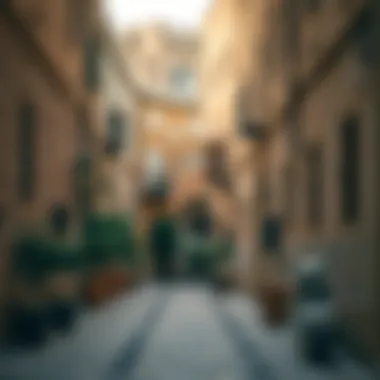

Recent trends indicate a noteworthy uptick in property values within Al Fahidi. Several factors drive this surge. First, the area's rich cultural heritage appeals to buyers looking for more than just a place to live but a lifestyle steeped in history.
- Cultural Appeal: Home to Dubai Museum and art galleries, Al Fahidi attracts a diverse group of people, from history buffs to art aficionados.
- Modern Amenities: While retaining its historic charm, Al Fahidi is not lagging behind in offering modern conveniences. Investors see opportunities in revitalizing old structures, turning them into chic cafes or stylish boutique hotels.
- Government Initiatives: Local authorities are investing heavily in enhancing infrastructure here, including better transport links and public spaces. This promotes further interest among buyers, boosting property prices.
The interest in preserving Al Fahidi’s unique character dovetails nicely with rising values, often outpacing other less historic neighborhoods.
Investment Opportunities
Investors eyeing Al Fahidi find a promising landscape filled with opportunities.
- Restoration Projects: Investors can capitalize on buying and restoring traditional houses, mixing modern design with historical aesthetics. This could result in significant returns, especially in an area where every brick tells a story.
- Tourism Ventures: As tourism continues to grow, developing hospitality-related projects can yield handsome returns. With tourists eager to experience culture-rich areas, boutique hotels and guesthouses can be particularly lucrative.
- Cultural Events: Property owners in Al Fahidi can collaborate with local artists and organizers to host cultural festivals and exhibitions. This not only elevates the area's status but also provides further revenue streams.
"Investing in historical areas like Al Fahidi is not just about real estate; it's about preserving the essence of a culture while paving the way for modern growth."
Given these factors, Al Fahidi is a microcosm of what's possible when history meets opportunity. Investors ready to navigate this unique market can find themselves part of a transformative journey that honors the past while embracing the future.
Demographic Considerations
The demographic landscape of Al Fahidi is intricate and significant, reflecting the rich tapestry of cultures that define Dubai as a whole. Understanding the demographics within this historic neighborhood is vital for investors, property buyers, and expatriates alike. The blend of local Emiratis and a diverse expatriate community shapes not only the cultural identity but also the economic vitality of Al Fahidi.
Expatriate Communities
Al Fahidi has become a melting pot for expatriates from all corners of the globe. Many newcomers call this area home, drawn by its historical charm and modern conveniences. The presence of various nationalities—such as Indians, Pakistanis, and Westerners—creates a dynamic community. This diversity enriches local culture with different cuisines, festivals, and traditions, making it not just a place to live but a vibrant community to participate in.
Countless expatriates feel a strong connection to Al Fahidi due to its character and community spirit. For those seeking investment opportunities, this neighborhood stands out. The expat demographic often drives demand for housing, contributing to an uptick in property values. Moreover, expatriates involved in the local art scene or heritage preservation efforts heighten interest in maintaining the area's cultural significance which can attract even more visitors and residents.
Local Residents and Cultural Identity
Local residents of Al Fahidi, primarily Emiratis, play a crucial role in preserving the neighborhood's identity. They are the guardians of the rich heritage that Al Fahidi boasts. The influence of local culture is palpable through various community events, traditional markets, and local artisans showcasing their crafts.
The coexistence of expatriates and locals leads to a unique cultural exchange that benefits both groups. Emiratis often share their customs and traditions with newcomers, fostering an environment of mutual respect and understanding. This interaction is more than mere cultural enthusiasm; it has significant implications for the socio-economic landscape in the area. By embracing both their heritage and the contributions made by expatriates, local residents ensure that Al Fahidi remains a bastion of cultural significance while also adapting to the modern urban environment it finds itself in.
In Al Fahidi, cultural richness lies in the fusion of old and new, with residents weaving stories both past and present.
Navigating the Neighborhood
Understanding how to navigate Al Fahidi is essential for anyone keen on exploring this vibrant area. The interplay between its historical structures and modern infrastructure creates a unique tapestry of experiences, especially valuable for investors and expatriates looking to immerse themselves in local culture. Getting around may seem simple, but the local nuances have a profound impact on how one interacts with the space.
Transportation Options
Al Fahidi's transportation options are varied, catering to both locals and visitors alike. The district is well-served by public transport, making it easy for anyone to delve into the heritage that resides within its confines.
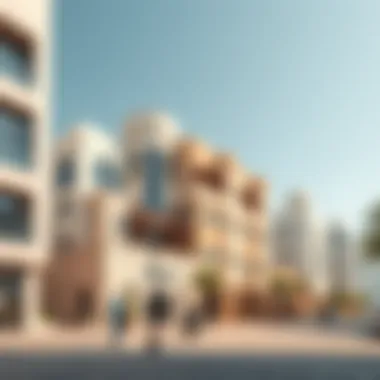

- Dubai Metro: The nearest metro station is Al Fahidi Station on the Green Line. This provides a direct connection to major parts of the city.
- Buses: Several bus routes crisscross through the area, allowing convenient travel not just within Al Fahidi but also to other neighborhoods.
- Taxis and Ride-Sharing: Taxis can be hailed from most locations, and ride-sharing services like Uber and Careem are widely accessible, making it easy to move around.
- Walking: Given the compactness of the neighborhood, walking is a preferred way to explore. The narrow alleyways are best experienced on foot; they tell stories of a time gone by, leading you from one cultural landmark to another.
This variety provides a straightforward way for both buyers and tourists to tap into the burgeoning real estate market, while investors can gauge the accessibility's impact on property values.
Accessibility Features
Navigating Al Fahidi isn’t just about available transportation; accessibility plays a crucial role in its functionality. Understanding these features can greatly enhance the experience for residents and visitors alike.
- Ramps and Pathways: Many historical sites have been equipped with ramps and adapted pathways, ensuring that individuals with mobility challenges can enjoy what Al Fahidi has to offer.
- Inclusive Design: A push towards inclusive urban planning is evident. The design of public spaces considers the needs of everyone.
- Public Amenities: Parks and recreational facilities cater to all, providing areas for respite and leisure.
- Signage: Clear signage in both Arabic and English helps guide visitors, further fostering an environment that welcomes foreigners and locals alike.
Al Fahidi's commitment to accessibility and diverse transport options demonstrates its integral role in the city's historical landscape. It not only enhances the overall experience for all visitors but also influences real estate prospects as areas become more navigable.
Future Developments
The future of Al Fahidi is not just a mere whisper in the wind; it’s akin to a vibrant tapestry weaving together history and modernity. This neighborhood, once a quiet corner of Dubai, is set to morph into a symbiotic blend of the old and new, offering massive opportunities for investors and residents alike. Understanding these forthcoming developments is crucial, as they promise to reshape both the cultural landscape and real estate dynamics. By examining urban planning initiatives alongside sustainability projects, we can glean insight into how Al Fahidi is preparing for a future that respects its rich past while embracing modernity.
Urban Planning Initiatives
Urban planning in Al Fahidi is like a fine watchmaker carefully adjusting tiny gears; each initiative is meticulously designed to enhance both the utility and aesthetic of the area. The Dubai government is prioritizing restoration projects that safeguard the integrity of this historical district. This is not just about preserving the buildings; it’s about creating a conducive environment for a thriving community.
- Promoting Mixed-Use Developments: New initiatives are looking to integrate residential, commercial, and cultural spaces seamlessly. Think cafes nestled within art galleries, allowing art lovers to sip coffee while contemplating a masterpiece.
- Enhancing Public Spaces: Parks and public squares are being planned to offer a breath of fresh air in a bustling neighborhood. They serve as communal hubs for gatherings, markets, and cultural events, drawing both locals and tourists.
- Improved Infrastructure: Upgrading roads, pathways, and public transport links will not only facilitate ease of movement but also increase property values in the area. Accessibility will be key to maintaining Al Fahidi’s relevance in Dubai’s evolving urban landscape.
Continuous dialogue with local communities ensures that these plans reflect the needs of its residents.
"Urban planning is like tending to a garden, where every step taken today shapes the blooms of tomorrow."
Sustainability Projects
In light of the global push for sustainability, Al Fahidi is keen on incorporating eco-friendly principles into its development strategy. These projects emphasize responsible resource use, reaffirming Dubai’s commitment to a greener future. The goals are ambitious, aiming to provide both environmental benefits and economic long-term advantages.
- Green Building Practices: Initiatives are underway to encourage the construction of buildings that adhere to sustainable building standards. This includes the use of energy-efficient materials, solar panels, and sophisticated waste management systems.
- Revitalizing Natural Spaces: Restoration of natural habitats within Al Fahidi is becoming a priority. This means enhancing green zones and incorporating flora that is native to the region, which can help to support local wildlife and improve air quality.
- Community Engagement in Sustainability: Local workshops are being established to educate residents about sustainable practices. When the community understands and values these initiatives, participation increases, leading to greater environmental impact.
The infusion of sustainability into Al Fahidi's future is not merely a trend; it’s a responsibility embraced by all stakeholders, ensuring that growth does not come at the expense of the environment.
Through these developments, Al Fahidi stands poised to not only remain a vital part of Dubai's heritage but to evolve into a model for how historical districts can thrive in a modern world.
The End
Al Fahidi stands out as a critical piece in the intricate puzzle of Dubai's historical and modern narrative. As this article has explored, its importance extends beyond just being a quaint neighborhood. It serves as a living museum, preserving the essence of Emirati culture while actively engaging with the contemporary demands of urban development.
The Role of Al Fahidi in Dubai's Future
As Dubai continues to grow and evolve, the role of Al Fahidi becomes even more pivotal. With its rich history anchored in the traditional lifestyle of the Emirati people, Al Fahidi is not just a relic of the past; it is a vibrant community that holds the key to the future of urban living in the region. Investors looking at opportunities here will find that Al Fahidi is a treasure trove. The increasing interest in cultural tourism and heritage conservation means that property values could see a marked rise.
- Cultural Rejuvenation: The momentum for preserving the historical character can lead to new business ventures. For instance, local artisans and craft shops thrive in spaces that highlight traditional skills, attracting both expatriates and tourists alike.
- Urban Integration: Al Fahidi is also perfectly positioned to bridge the economic divide between old and new Dubai. The developmental initiatives aimed at enhancing connectivity, alongside sustainability projects, illustrate how this neighborhood is being integrated into the broader Dubai vision.
"Preserving Al Fahidi is not just an act of remembrance; it is about ensuring that future generations appreciate where they come from while embracing what lies ahead."






